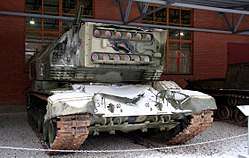1K17 Szhatie

The 1K17 Szhatie (Russian: 1К17 Сжатие — "Compression") is a self-propelled laser vehicle of Soviet origin. The platform uses a Msta-S chassis with a battery of laser projectors mounted in the turret. It was developed by the Soviet Union in order to disable the optical-electronic equipment of enemy missiles, ground and aerial vehicles.
History
The 1K17 Szhatie was developed in the 1970s and 1980s. Although the Soviet Union attempted to keep the plans secret, the Pentagon managed to obtain drawings from defectors. Western intelligence services code named it the Stiletto. With the collapse of the Soviet Union, the development of the Szhatie was abandoned, as the development and manufacturing of the laser projection system had become too expensive and unnecessary. Two of these "tanks" were tested, with one being scrapped and the other being displayed in the Army Technology Museum near Moscow, but without its laser projector.
The Russian Armed Forces already have been commissioned some types of laser weaponry, Russian Deputy Defense Minister Yuri Borisov said on 2 August 2016. These might be laser systems for jamming tank armament command systems or air defence/anti-missile systems.[1][2][3] The first of these laser systems were supplied to the Russian Armed Forces in 2017 according to President Vladimir Putin and Borisov later claimed that these systems are able to destroy hostile targets instantly.[4][5]
Design
The "tank" used an intense laser beam to disable the optical-electronic equipment of the enemy vehicles. This was created by focusing light through 30 kg of artificial rubies which made the whole system very expensive to produce. The optics that produced the laser were placed at the end of a silver coated spiral which helped amplify the beam and increase convergence. The energy to power the laser was provided by a generator and an auxiliary battery system. The lenses themselves were able to operate in different environments by moving metal caps closer to protect the lens. It was also equipped with a 12.7mm NSV machine gun to defend itself against attacks by infantry and air.
A similar laser system was also developed around the same time named "Sangvin", which was based on the ZSU-23-4 self-propelled anti-aircraft gun.[6]
References
- ↑ Sputnik. "Russia's Ray Guns: The Military Capability of Moscow's Secret Laser Weapons". sputniknews.com.
- ↑ Sputnik. "Future is Here: Russian Army Already Uses Several Types of Laser Weaponry". sputniknews.com.
- ↑ Sputnik. "Nuclear-Powered Anti-Missile System? What Russia's Combat Laser May Be Used For". sputniknews.com.
- ↑ "Putin announces Russia possesses hypersonic weapons".
- ↑ "Russian combat lasers can destroy hostile targets - Defense Ministry".
- ↑ "Боевые квантовые генераторы СССР" [Military quantum generators of the USSR]. army-news.ru (in Russian). Армейский вестник. Retrieved 2018-03-04.
External links
![]()